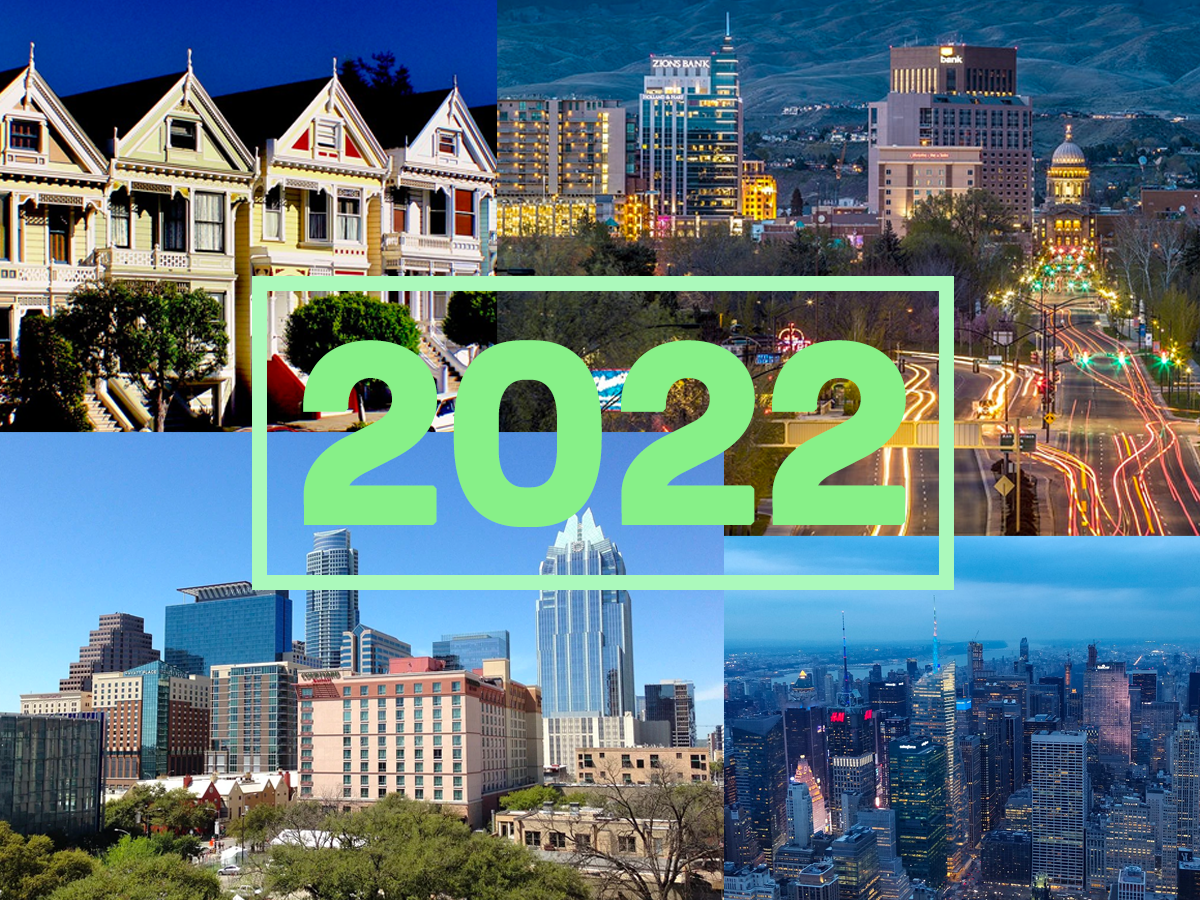As 2021 draws to a close, we’re looking ahead for our annual real estate market predictions, 2022 edition.
There are two big variables that could impact how things might play out. First, whether the prices of lumber and building materials that have spiked over the past year will correct, continue at elevated levels, or possibly even continue to climb.
The second factor is whether or not the Federal Reserve will do anything about high levels of inflation and raise interest rates.
So far, there haven’t been strong indicators that they will. As such, the following real estate market predictions for 2022 assumes fiscal policy and commodity prices will continue in the same trend they are now – upwards.
Here are HappyNest’s five real estate predictions for 2022.
1. The housing market will continue to see double digit growth
After an unbelievable year that saw appreciation rates nearing 20% on the tail of 2020’s 7% gains, people began to wonder if perhaps we are in a housing bubble.
We’re probably not. The reason is that much of the influx of demand that came into the market is investment institutions (hedge funds, banks, etc.).
While the mainstream media claims it’s Millennials entering the market, this is simply not true. First of all, there is always some organic turnover as young adults reach their home-buying years. Millennial have been very delayed in this regard. After a decade of setbacks, those entering the housing market for the first time represent a minority of buyers. Additionally, many of them are buying as couples – even friends are teaming up – as homeownership would otherwise be unattainable.
The Federal Reserve has kept interest rates as 0% since the onset of the pandemic. That money is lent out to big banks. This money finds its way into various investment vehicles – hedge funds, private equity, etc. – who have been buying up houses like hotcakes. Earlier this year, Zillow accidentally over-purchased almost 7,000 homes.
However, the Fed’s low interest rates aren’t being passed onto consumers. While mortgage rates are low, the criteria around who can get mortgages in the first place has tightened.
Bank lending multiples have declined significantly over the last decade. Now, the average mortgage lending multiple is about two and a half times the borrower’s income. Less than five years ago, it was about four times the annual income of applicants with good credit.
With the Fed’s printer still humming and interest rates still near zero for banks, there’s no reason to think they will cease buying up houses, adding a steady stream of demand side pressure and driving up prices in the housing market.
2. The Industrial and Logistics sector will have exponential growth
Our real estate market prediction for 2022 is the industrial and logistics sector will continue its exponential year-over-year growth.
The massive growth in e-commerce that started accelerating aggressively at the onset of the pandemic has held strong through 2021, as we predicted. As of right now, there’s no discernible reason to think that trend will slow down in 2022.
Filling all those online orders requires big industrial shipping facilities, much like HappyNest’s flagship property. Currently on a 10-year lease with FedEx, the real estate market outlook for this sector is so promising, rent increases are already in the lease terms.
The warehouse market has seen tremendous growth, and trucking remains the primary domestic transportation route. As retailers continue to scale up their e-commerce activities, the demand for these limited-supply properties will drive prices even further up. There have already been reports of warehouse lease rates soaring due to skyrocketing demand. Every one of those warehouses will need semi trucks to deliver the stock to retailers or consumers, therefore the need for industrial properties sustaining or continuing its appreciation is all but guaranteed.
HappyNest’s industrial property is in a strategic location for nationwide operations. It is located in Fremont, Indiana. It is nestled between three major interstate in America’s heartland for maximum efficiency.
3. Office real estate will improve, but not recovery fully from the pandemic
One real estate market sector that might experience growth on a year-over-year basis is the office sector. However, that growth will only partially recover from the dive the sector took from the onset of the pandemic. That’s because a huge portion of the remote work force doesn’t want to return to the office.
For that reason, a year-over-year perspective doesn’t provide the scope needed to understand this corner of the real estate market.
Because since then, several large-scale companies have announced that they will not require large portions of their workforce to return to the office at all. Additionally, small and mid-sized businesses appreciate the financial lift off their operational overhead now that they’ve worked out the logistics of running their companies remotely.
With an influx of supply and reduced demand, out real estate market prediction for the office space sector is a reduction in rates to seduce companies into leases and recondition them to the 9-to-5 work life the pandemic interrupted.
With new virus variants creating some uneasiness around calling the workforce back into the office, this sector may find themselves with vacancies on their hands long-term. Buildings whose zoning support it may find a different use cases, such as an AirBnB, housing, or hotel conversion.
4. Investment capital will continue to sweep into all sectors
With the Federal Reserve keeping interest rates at zero, thereby making lending capital to banks and financial institutions all but risk free, more investment capital will flow into all real estate sectors.
Considering the back drop of high inflation levels, keeping cash on hand is somewhat of a liability for banks. No where is this better evidenced than the Federal Reserve’s reverse repo market. The use of the fed’s reverse repo is at all time highs – and on an eye-popping exponential curve.

Real estate has long been a hedge against inflation. Continuity of current policy is the Federal Reserve implicitly encouraging large financial institutions to buy up assets in quantity. From financial institutions’ perspective, while capital is available at 0% interest rates, why not keep adding assets to their balance sheets?
The reality is, in light of the tremendous double-digit gains in several real estate sectors (notably, the housing market and industrial sector), even what would usually qualify as a major correction wouldn’t fully undo the gains since 2020.
Until the Federal Reserve signals a meaningful change in policy, such as raising interest rates or pulling cash out of circulation, it is our real estate market prediction that the real estate market at large will continue to see increased demand in all sectors.
Compounded with the private sector’s strong interest in real estate and you’ve got a recipe for big pumps. Investors want to be on the right side of that.
5. Migrations and mass relocations will have regional effects
Ever since the major shutdowns of 2020 that have meaningfully reshaped the workforce and untethered former office workers from their workplace, some cities are experiencing major exoduses while others are experiencing major influxes.
Austin, Texas in particular has seen tremendous growth. In 2020, Austin’s population grew by almost 3.5%. Partially thanks to Elon Musk, Austin’s population is on track to gain another 3.6% in 2021. Several large companies, including Apple and Google either have plans to move or expand operations through 2022.
Of course, the people moving to cities like Austin and others that are experiencing growth are coming from somewhere. Notably, all three companies with plans to move to Austin are currently headquartered in the Greater San Fransisco Bay Area. This exodus of thousands of jobs is already being felt in Bay Area real estate prices.
Likewise, Boise, Idaho has experience tremendous growth over the last two years, and housing prices have followed suit. Major metropolises like New York City and Chicago have experienced population contractions.
Large-scale population shifts will be felt asymmetrically across the nation as supply-demand dynamics change on a regional level.
HappyNest’s real estate market prediction
As our final real estate market prediction, HappyNest remains confident in its portfolio performance for 2022 and beyond. We remain well fortified against the uncertainties in the times ahead. Properties in our portfolio will presumably remain in demand as well as appreciate. We are not anticipating any vacancies. With strong, financially stable tenants on long-term leases, we expect rent income to continue uninterrupted for the foreseeable future.
We look forward to sharing the wealth and paying out to HappyNest shareholders in the form of quarterly dividends and property value appreciation.
Wishing you a happy holiday season and a prosperous New Year from all of us here at HappyNest.





